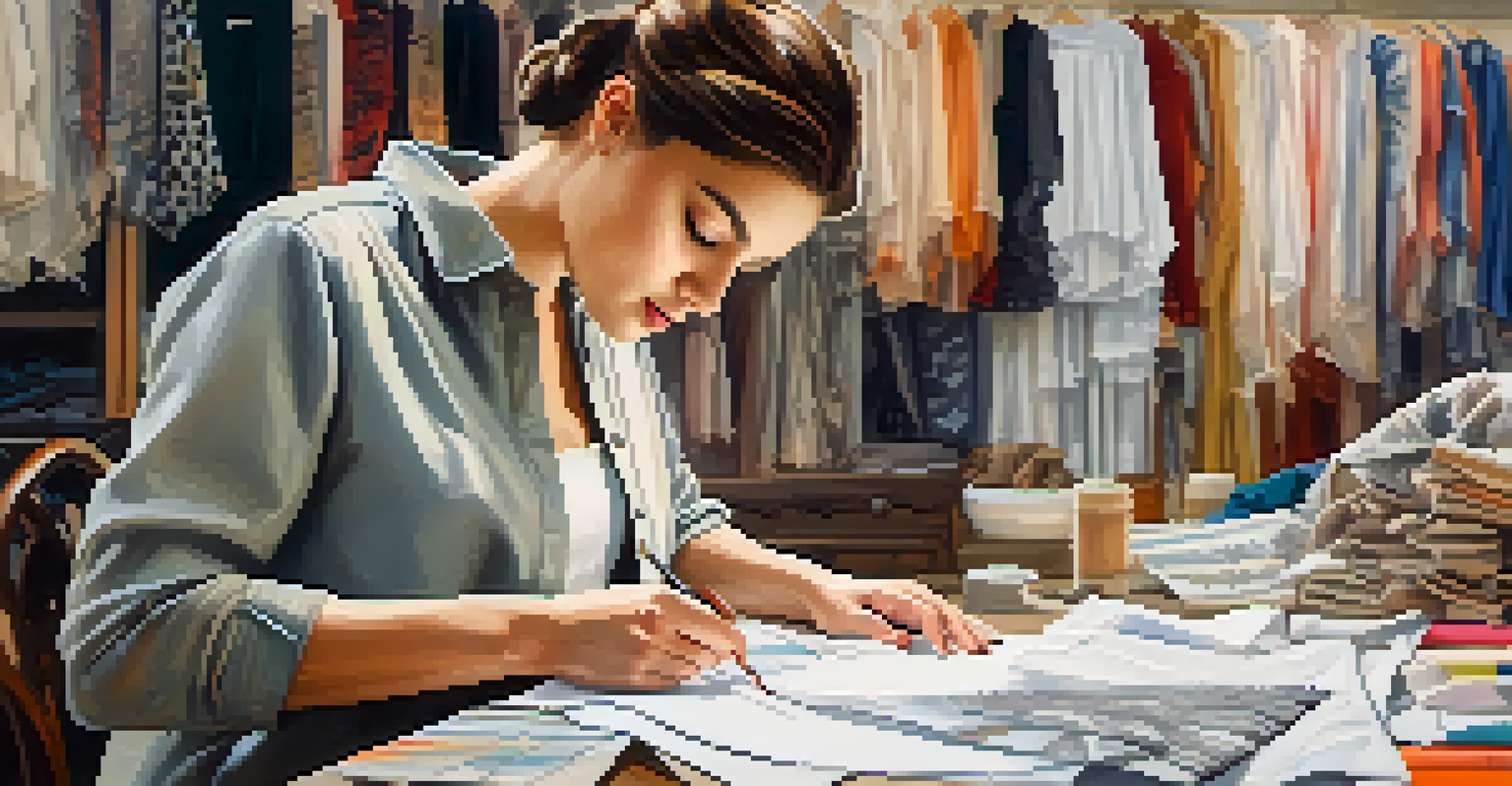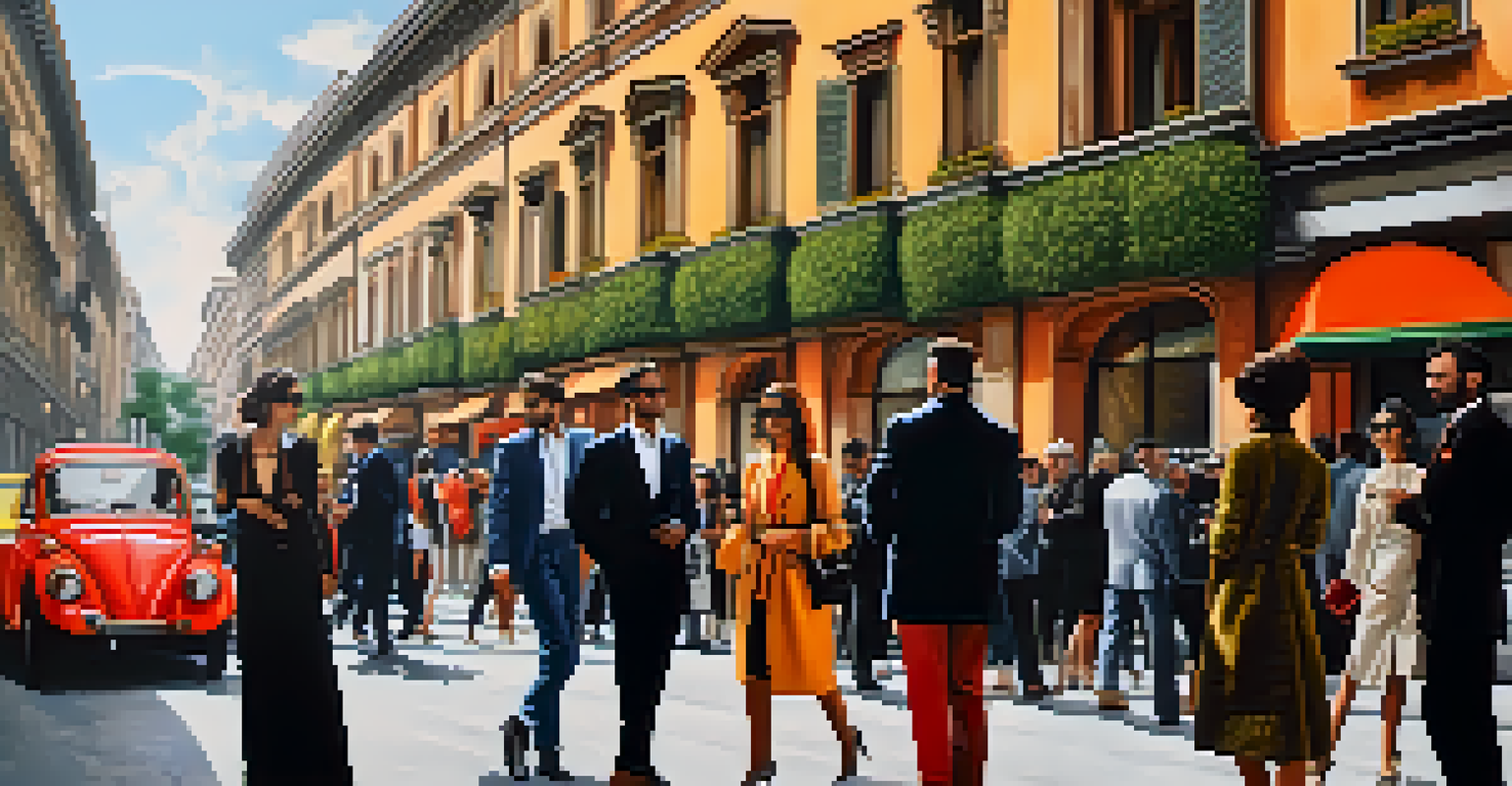Milan Fashion Week: Merging Tradition with Modern Fashion

The Heritage of Milan Fashion Week: A Glorious Beginning
Milan Fashion Week has a rich history that dates back to 1958, showcasing the artistry of Italian fashion. This event has evolved into one of the most prestigious fashion weeks globally, drawing attention from designers, models, and fashion enthusiasts alike. The roots of this event lie in a deep appreciation for craftsmanship and traditional styles, which still resonate in today's collections.
Fashion is the armor to survive the reality of everyday life.
Throughout the decades, Milan has remained a beacon of luxury and sophistication, where iconic brands like Gucci and Prada have flourished. This heritage influences new designers who strive to honor the past while innovating for the future. The juxtaposition of classic techniques with modern sensibilities creates a unique narrative that captivates audiences.
As we dive into each season, the spirit of Milan Fashion Week celebrates its legacy while embracing contemporary trends. By merging tradition with innovation, designers honor their roots while appealing to the evolving tastes of modern consumers. This blend not only enriches the fashion landscape but also attracts a diverse global audience.
Key Designers: Pioneers of Tradition and Modernity
Milan is home to some of the world's most influential designers, who skillfully weave traditional elements into their modern collections. Designers like Giorgio Armani and Dolce & Gabbana have successfully created pieces that reflect their cultural heritage while appealing to contemporary audiences. Their ability to blend past and present is central to their design philosophy.

Emerging designers are also making waves by drawing inspiration from traditional craftsmanship. For instance, brands like Genny and Etro incorporate artisanal techniques while experimenting with bold designs that resonate with younger generations. This approach not only revitalizes classic aesthetics but also keeps the fashion scene fresh and exciting.
Heritage Meets Modern Innovation
Milan Fashion Week beautifully blends traditional craftsmanship with contemporary design, creating a vibrant narrative that appeals to diverse audiences.
As these designers showcase their collections, they highlight how tradition can coexist with modernity, creating a dialogue between generations. The craftsmanship behind each piece tells a story, connecting wearers to a rich cultural tapestry. This ongoing conversation is what keeps Milan Fashion Week dynamic and relevant in the ever-evolving fashion world.
Sustainable Fashion: Reviving Traditional Techniques
In recent years, sustainability has become a focal point at Milan Fashion Week, with many designers embracing eco-friendly practices. By reviving traditional techniques, they reduce waste while celebrating craftsmanship. This movement recognizes the importance of preserving cultural heritage while addressing modern environmental concerns.
Style is a way to say who you are without having to speak.
For example, brands are reintroducing handwoven textiles and natural dyes that have been used for centuries. By doing so, they not only promote sustainability but also tell a story about their roots. This blend of old and new approaches resonates with conscious consumers looking for authenticity in their fashion choices.
Sustainability at Milan Fashion Week illustrates how tradition can inform modern practices, creating a more responsible fashion landscape. As designers continue to innovate while respecting the past, they pave the way for a more sustainable future in the industry. This commitment to both heritage and innovation is essential for the evolution of fashion.
Fashion Innovation: Technology Meets Tradition
As technology rapidly evolves, Milan Fashion Week embraces innovation without losing sight of its traditional roots. Designers are increasingly incorporating cutting-edge technology into their creative processes, from 3D printing to digital fashion shows. This fusion of technology and craftsmanship is reshaping the way we experience fashion.
For instance, some brands use augmented reality to enhance runway experiences, allowing viewers to engage with collections in real-time. This not only elevates the spectacle but also opens up new possibilities for storytelling in fashion. By merging traditional aesthetics with technological advancements, Milan Fashion Week is setting the stage for a new era of creativity.
Sustainability as a Core Value
Many designers at Milan Fashion Week are embracing sustainability by reviving traditional techniques, thus promoting eco-friendly practices while honoring cultural heritage.
The integration of technology serves as a bridge between generations, appealing to both traditionalists and tech-savvy consumers. As designers explore these new frontiers, they honor the past while boldly stepping into the future. This balance of innovation and tradition is what keeps Milan Fashion Week at the forefront of the fashion industry.
Cultural Influences: A Global Perspective on Milan Fashion
Milan Fashion Week serves as a melting pot of cultures, showcasing designs that reflect global influences. Designers draw inspiration from various cultures, enriching their collections with diverse aesthetics. This fusion of ideas results in innovative designs that resonate with a broad audience, transcending geographical boundaries.
For instance, incorporating elements from African prints or Eastern textiles can be seen in the collections of several Milan designers. This cultural exchange not only celebrates diversity but also challenges traditional norms, fostering a more inclusive fashion landscape. As a result, Milan Fashion Week becomes a platform for dialogue and understanding among different cultures.
The global perspective represented at Milan Fashion Week highlights the interconnectedness of the fashion world. As designers share their interpretations of cultural influences, they contribute to a richer, more vibrant fashion narrative. This celebration of diversity reinforces Milan's status as a global fashion capital.
The Role of Fashion Shows: A Blend of Art and Commerce
Fashion shows at Milan Fashion Week are not just about showcasing new collections; they are theatrical experiences that blend art and commerce. Designers curate elaborate presentations that captivate audiences, telling a story through every detail, from the venue to the music. This artistic approach elevates fashion to a form of entertainment.
Moreover, these shows serve as critical marketing tools, attracting buyers and media attention. The spectacle of a Milan runway can significantly influence trends and sales, demonstrating the power of visual storytelling in fashion. This balance between artistic expression and business acumen is what makes Milan Fashion Week uniquely compelling.
Cultural Diversity in Fashion
The event showcases a fusion of global influences, enriching collections and fostering a more inclusive fashion landscape that celebrates diversity.
As we witness these elaborate productions, we gain insight into the designer's vision and the brand's identity. The fusion of creativity and commerce reflects the dynamic nature of the fashion industry. At Milan Fashion Week, this blend not only showcases talent but also drives the business forward.
The Future of Milan Fashion Week: Tradition Meets Innovation
Looking ahead, Milan Fashion Week is poised to continue its legacy of merging tradition with innovation. As the fashion industry evolves, so too will the event, adapting to new trends and consumer demands. The commitment to preserving cultural heritage while embracing modernity will remain at the core of its identity.
Emerging designers are expected to play a crucial role in shaping the future of the event, bringing fresh perspectives and ideas. As they challenge the status quo, they will further enrich the Milan fashion landscape, ensuring its relevance in a rapidly changing world. This dynamic interplay between established and new talent is essential for the growth of the industry.

Ultimately, Milan Fashion Week will continue to inspire and engage audiences, showcasing the beauty of fashion as a reflection of our collective culture. By balancing tradition with innovation, the event will remain a vital part of the global fashion dialogue, celebrating both the past and the future.